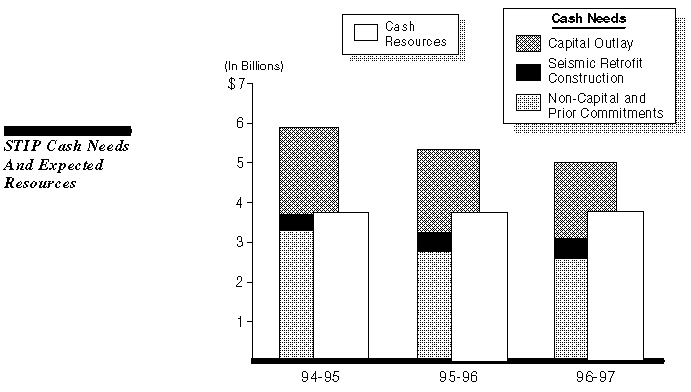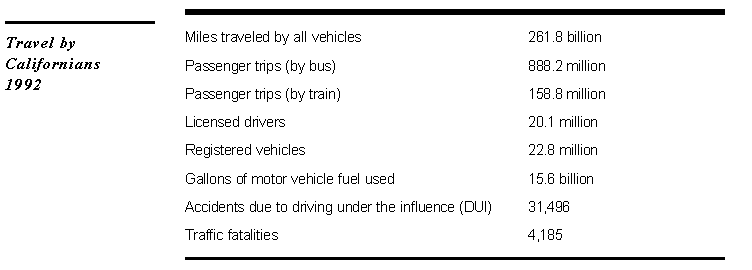
 Legislative
Analyst's Office
Legislative
Analyst's Office
Californians travel a great deal within the state, with most travel being done on the state's highways and roads. Californians also rely heavily on mass transportation systems--rail and bus transit--to get around the state.

Highway and mass transportation services are funded with a combination of federal, state, and local money. In general, the state Department of Transportation (Caltrans) is responsible for constructing, operating, and maintaining all state highways, while streets and roads are under the jurisdiction of local government. The state also provides intercity rail services connecting cities, while local entities provide urban and commuter rail services and public bus transit services.
Traffic enforcement is the responsibility of the Department of Motor Vehicles (DMV) and the California Highway Patrol (CHP). Specifically, the DMV licenses drivers and registers vehicles while the CHP enforces compliance with traffic laws and regulations.
User fees are the main source of funds for California's surface transportation activities- -highways, roads and streets, passenger rail service, and mass transit bus services. These fees include primarily fuel taxes (federal and state), vehicle fees, and passenger fares. Of the three levels of governments, the state provided the largest portion of 1993-94 transportation funds.
In 1993-94, about 63 percent of all transportation funds were expended on highways and roads throughout the state. The remaining transportation funds were spent for mass transportation purposes, including passenger rail service and mass transit bus service.
For every gallon of gasoline a motorist buys in California, the price paid "at the pump"--assuming $1.50 for illustration--includes 48 cents in federal and state taxes mainly for transportation purposes. The following figure shows the sources and uses of these tax revenues.
Fuel tax revenues for the state highway system have failed to keep pace with the growth in highway driving. This is mainly because the fuel tax is levied as a fixed amount per gallon. Thus, total tax revenues are determined by the number of gallons of fuel consumed. However, as vehicles become more fuel efficient, they burn less fuel for each mile driven.
As a result of several increases in the fuel excise tax, gas tax revenues are now slightly above the 1970 level (after adjusting for inflation), but over the same period driving has more than doubled.
The state's surface transportation program is scheduled for funding primarily in the State Transportation Improvement Program (STIP). The STIP is adopted biennially by the California Transportation Commission, and covers a seven-year period. The STIP contains all major projects to be funded with state money during that period for the interregional road system; the intercity rail, commuter and urban rail systems; the flexible congestion relief program; transportation enhancement activities; and the retrofit soundwall program.
Projects designed to rehabilitate and improve the safety of the state highway system and projects designed to manage the flow of traffic (such as, by installing traffic signals and message systems) are listed in programs other than the STIP. However, the STIP sets aside state funds for these projects.
The 1994 STIP projects the amount of transportation revenues available for 1994-95 through 2000-01 and allocates those funds among various uses including support for Caltrans, local assistance, and capital outlay improvements. Over seven years, the 1994 STIP anticipates that $12 billion will be used for Caltrans' departmental support, including highway maintenance and capital outlay project support. In addition, the 1994 STIP includes over $9 billion in capital outlay projects scheduled for delivery during that period. These capital outlay projects are divided between projects that expand the capacity of the transportation system (the STIP program) and projects that improve or renovate the existing system without adding new capacity (the non-STIP programs).
The state transportation program for the period 1994-95 through 2000-01 will be larger than that scheduled in the 1994 STIP and approved by the California Transportation Commission (CTC). This is because, following the Northridge earthquake, Caltrans identified additional highway bridges that need to be retrofitted to earthquake safety standards, at an estimated cost of about $1 billion.
In addition, the STIP contains $1 billion in programmed rail projects that were expected to be funded out of the 1994 rail bond (Proposition 181) that failed in the November 1994 election. Furthermore, as a result of lower-than-anticipated federal funds and actions taken in the 1994-95 budget, the CTC now anticipates resources to be less over the seven- year period. Consequently, commission staff estimates that in order to construct all projects programmed in the STIP and to complete all anticipated seismic retrofit work would require about $2.5 billion more in funds.
Over the next three years (through 1996-97), Caltrans estimates that available cash will be insufficient to construct all projects scheduled to be delivered in that period, including completing the seismic retrofit program. Part of this cash shortfall is the result of adding $1 billion in new seismic retrofit projects to the existing transportation program. However, the figure illustrates that even without seismic retrofit, substantial cash shortfalls would still exist. The recent failure of Proposition 181, which would have provided $1 billion for rail projects in the STIP, increases the severity of the cash shortfall. Part of the gap may be addressed by borrowing from future federal and state highway funds, but this would reduce funds available in later years.
TRANSPORTATION FUNDING
User Fees Are Primary Funding for Transportation Programs
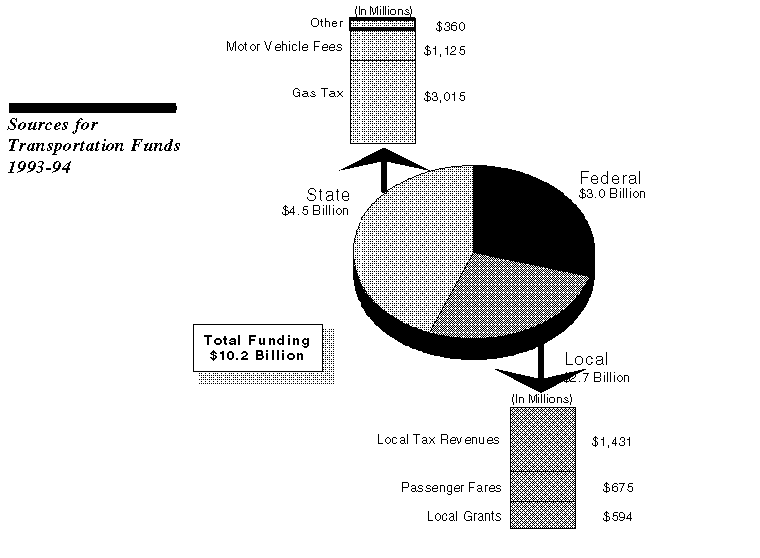
Most Transportation Expenditures Are for Highways and Roads

Motorists Pay Fuel Taxes At the Pump
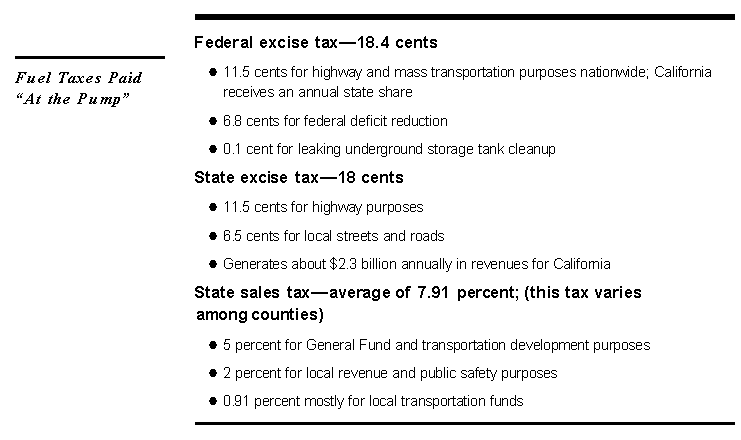
Traffic Growth Outpaces Fuel Tax Revenue
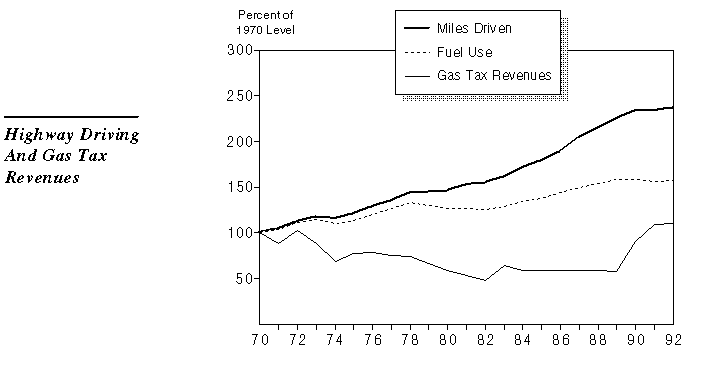
TRANSPORTATION PLANNING
The STIP Schedules Major Projects for State Funding
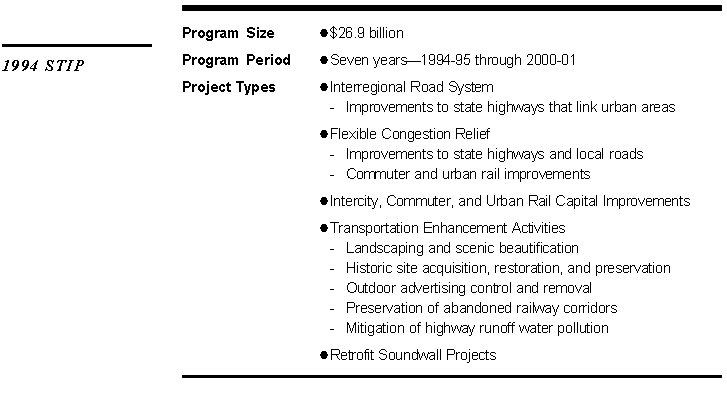
1994 STIP Has Over $9 Billion In Capital Improvement

1994 STIP Short by $2.5 Billion

There Is Insufficient Cash for Transportation Projects
